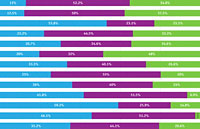 There’s an interesting chart over at io9 that “Reveals How Science Fiction Futures Changed Over Time.” The accompanying article, by Annalee Newitz, discusses the methodology for creating the chart, by Stephanie Fox.
There’s an interesting chart over at io9 that “Reveals How Science Fiction Futures Changed Over Time.” The accompanying article, by Annalee Newitz, discusses the methodology for creating the chart, by Stephanie Fox.
They divided the future into three ranges — Near Future (up to 50 years from the “present”); Middle Future (51-500 years out); and Far Future (501+ years) — then looked at literature published each decade from the 1880s through 2000s.
If you click the thumbnail at right, you can see a larger version of the chart. (Or click here to read the article on io9.)
Newitz analyses the survey of SF stories and provides some conclusions based on the results. But she doesn’t spend much time on the 1930s, when the bulk of SF stories took place more than 500 years in the future. That was the age of Space Opera, one of my favorite pulp genres.
Technology was developing at a quickening pace; aircraft were flying all around the globe; so why wouldn’t spaceflight be just over the horizon? And just beyond that, we’d be flying between the planets, and then the stars.
I was on a big Captain Future kick a few years ago (then moved on to Asimov, including his sweeping Foundation series — which does span beyond those 500 years). What makes those stories so appealing is the excitement that the writers had — that we’d be out there at some point in the future and they were giving readers of the pulps a glimpse at what to expect.
This all, of course, was before most folks had any idea what was actually out there. And before spacecraft began sending back photos of barren, cold worlds, uninhabited by other humanoids or odd creatures.
The 1930s (and early ’40s) was a golden spot where everything and anything could happen in the future. And it was all right there in Amazing Stories, Astounding and other pulp magazines.



Fascinating. Charts like this really illustrate the zeitgeist of these decades. In the thirties, when memories of the Great War were still fresh in the collective consciousness and Europe was making the first movements that would lead to WWII, one can imagine the interest in the long-term prognosis for western society. The chance to escape to the far-flung future must have been tantalizingly irresistible. By contrast, a look at the nineties shows stories about distant futures were virtually non-existent. I remember the nineties as an incredibly optimistic time; the cold war was over, technology was weaving its way into our lives at a rate never before seen, Germany was reunited in perhaps the most significant and dramatic political sea-change that I’ve witnessed in my lifetime. Looking back, it seems the West was all smiles for that brief moment. I guess people were more interested in exploring the optimism they felt for their more immediate future.
Of course, maybe I’m just projecting and reading my own presuppositions into the chart.